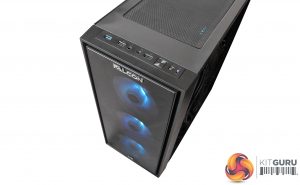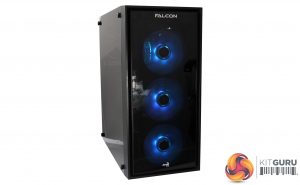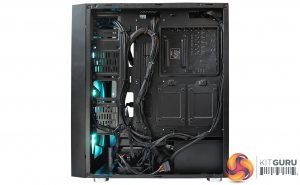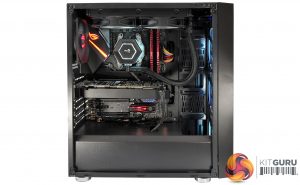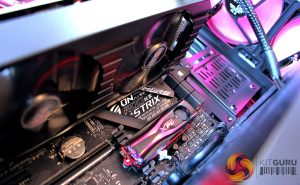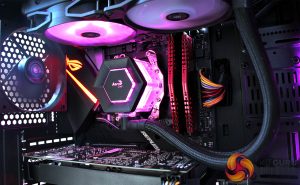The Falcon Project X VR Ready Gaming PC is one of the smallest ATX PCs we’ve seen for a long time, thanks to its Aerocool Quartz RGB chassis. The dimensions are impressive: this enclosure is just 206mm wide and 455mm tall.
That makes the Falcon machine more compact than many rivals. The PC Specialist Enigma Pro used a Corsair case that was almost 500mm tall, and while the CyberPower Infinity X66 GTX and Overclockers UK Cobalt were a tiny bit shorter, they were a little longer and wider, too.
There may not seem like a huge size difference between the Falcon and its rivals, but it’s important to bear that in mind if you’re planning a rig for a home office, a living room or another location where space is at a premium.
The compact Quartz chassis looks smart, too, and offers solid build quality. The front panel is made from tempered glass with a rim around the edge to allow for air intake, and the top is dominated by a magnetic dust filter. Build quality is excellent on the outside, with sturdy metal and glass used throughout – so there'd be no problem transporting this compact computer to gaming events.
The dark, glossy design looks smart at first – almost like a business PC. Turn the Falcon on, though, and the Quartz comes alive. The front panel houses three 120mm fans that glow with RGB LEDs that rotate through a selection of soft shades. Smartly, the lighting can also be customised using an Aerocool app from within Windows.
It’s a solid start for this mid-range PC, but there are also some features missing. There’s no hardware button on the front of the case to alter the lighting, and there’s only one USB 3.0 port – the other two use the older, slower USB 2.0 standard. There’s no USB 3.1 Type-C at the front, either.
The tempered glass side panel is secured with four thumbscrews. It’s a sturdy panel, and removing it reveals a smart and well-designed interior. At the bottom is a PSU shroud – the kind of addition that’s found on most PCs these days. This keeps the bottom of the machine tidy by hiding the power supply and its cables, and it also houses two hard disk bays.
Around the back you’ll find two 2.5in mounts for adding SSDs or small hard disks.
An Aerocool P7-L240 liquid cooling unit is installed in the roof, and its two cables snake down to the processor. The waterblock is smart, with an angled top and an acrylic body that glows with RGB LEDs in sync with the PC’s intake fans. The two fans on the water-cooling unit are RGB-equipped, too.
Falcon has done a good job building this PC. The cables at the bottom of the rig are tied down and kept out of the way, and the main power cables are routed sensibly – so it’s easy to work inside this machine.
There’s a lot to like about the Aerocool Quartz case and Falcon’s tidy building, but this smaller chassis does have its limits. There may be two hard disk bays, for instance, but they’re both occupied – one with the hard disk, and the other with the fan controller. That restricts the amount of storage you can add to this machine.
Elsewhere, the PSU shroud is smart but a little flimsy, and it can be difficult to reach certain parts of this machine for upgrade work. The water-cooling unit and its two fans make accessing the top of the memory slots difficult. The graphics card almost encroaches on the SATA ports, and the PSU shroud and connectors at the bottom of the board make it difficult to use the bottom PCI-E slot.
If you don’t plan to upgrade this machine, that won’t be a problem. However, if you are keen to tinker, it may be worth looking into rivals that have a little more room.
Still, it’s a good bill of health for a PC at this price. The interior is smarter and easier to work with than the Phanteks case included in the Overclockers PC, and the PSU shroud ensures that it’s much neater than the Corsair case included with the PC Specialist – even if that case is more spacious. Only the In-Win 101 used by the CyberPower system offers a little more in terms of expansion, but that case is a little untidy and flimsy.
 KitGuru KitGuru.net – Tech News | Hardware News | Hardware Reviews | IOS | Mobile | Gaming | Graphics Cards
KitGuru KitGuru.net – Tech News | Hardware News | Hardware Reviews | IOS | Mobile | Gaming | Graphics Cards


